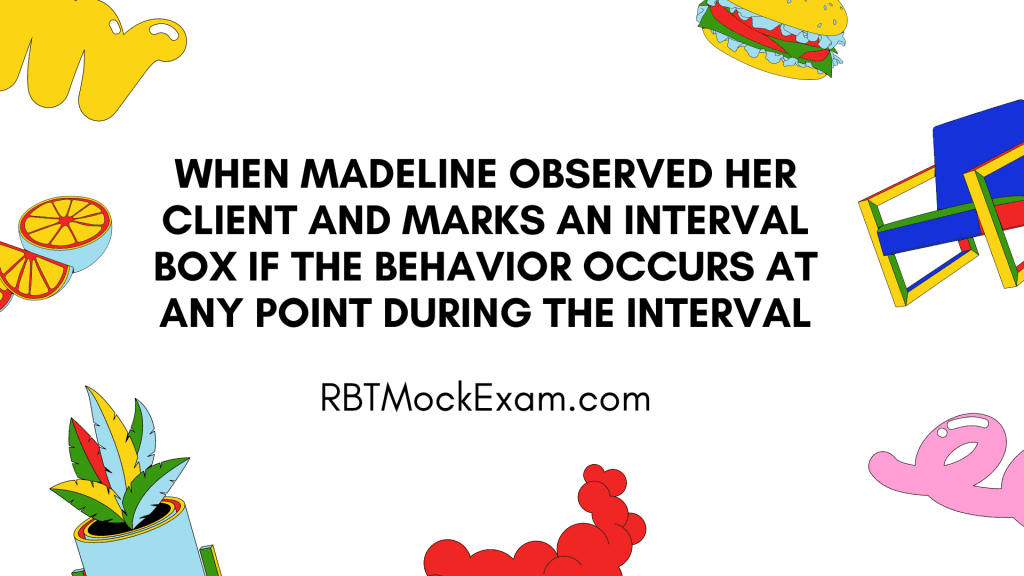When Madelyn observes her client and marks an interval box if the behavior occurs at any point during the interval. Madelyn is using:
Options:
A. Momentary Time Sampling
B. Partial Interval Recording
C. Whole Interval Recording
Correct Answer: B. Partial Interval Recording
Explanation: Partial Interval Recording is a method of observation where the observer records whether the behavior occurred at any point during the interval. This method is often used for behaviors that are short in duration and may not occur throughout the entire interval.
It estimates the behavior’s occurrence and can overestimate its actual duration because it marks the interval as positive even if the behavior occurred only briefly.
Partial Interval Recording is indeed the method Madelyn is using. Here’s a more detailed breakdown of this method and how it differs from the other options:
- Partial Interval Recording (PIR):
- In PIR, the observer marks the interval if the target behavior occurs at any time during that interval, even if only briefly.
- It’s particularly useful for brief behaviors or at low frequencies.
- PIR tends to overestimate the actual duration of behavior, as the entire interval is marked even if the behavior only occurred for a moment.
- Advantages:
- Sensitive to detecting low-frequency behaviors
- Good for capturing behaviors that occur sporadically
- Useful for behaviors that are difficult to time precisely
- Limitations:
- Can overestimate the occurrence of behavior, especially for high-frequency behaviors
- May not accurately represent the true duration of the behavior
- Momentary Time Sampling (Not the correct answer here):
- In MTS, the observer only checks if the behavior is occurring at the exact end of each interval.
- It’s like taking a snapshot of behavior at specific time points.
- MTS tends to provide a more accurate estimate of the percentage of time a behavior occurs, especially for high-frequency behaviors.
- Whole Interval Recording (Not the correct answer here):
- In this method, the behavior must occur throughout the entire interval to be recorded.
- It tends to underestimate the duration of behavior.
- Best for behaviors that typically occur for extended periods.
Key Differences:
- PIR records if the behavior happens at any time during the interval.
- MTS focuses on a single moment at the end of each interval.
- Whole Interval requires the behavior to last the entire interval to be recorded.
When to Use Partial Interval Recording:
- For behaviors that are brief in duration
- When observing low-frequency behaviors
- When it’s important to capture any instance of the behavior, even if brief
- In situations where precise timing of behavior duration is difficult
Considerations for Using PIR:
- Interval length: Shorter intervals can provide more precise data but require more effort from the observer.
- Observer training: Ensure observers are well-trained to recognize the onset and offset of the target behavior.
- Data interpretation: Remember that PIR tends to overestimate behavior duration when interpreting results.
- Complementary measures: Consider using PIR in conjunction with other measures for a more comprehensive assessment.
In Madelyn’s case, by marking the interval if the behavior occurs at any point during it, she is clearly using Partial Interval Recording. This method allows her to capture instances of the behavior even if they are brief or occur infrequently, making it a valuable tool for certain types of behavioral observations.





